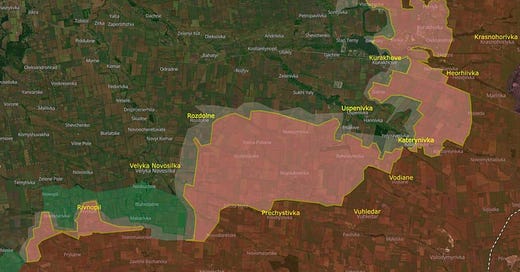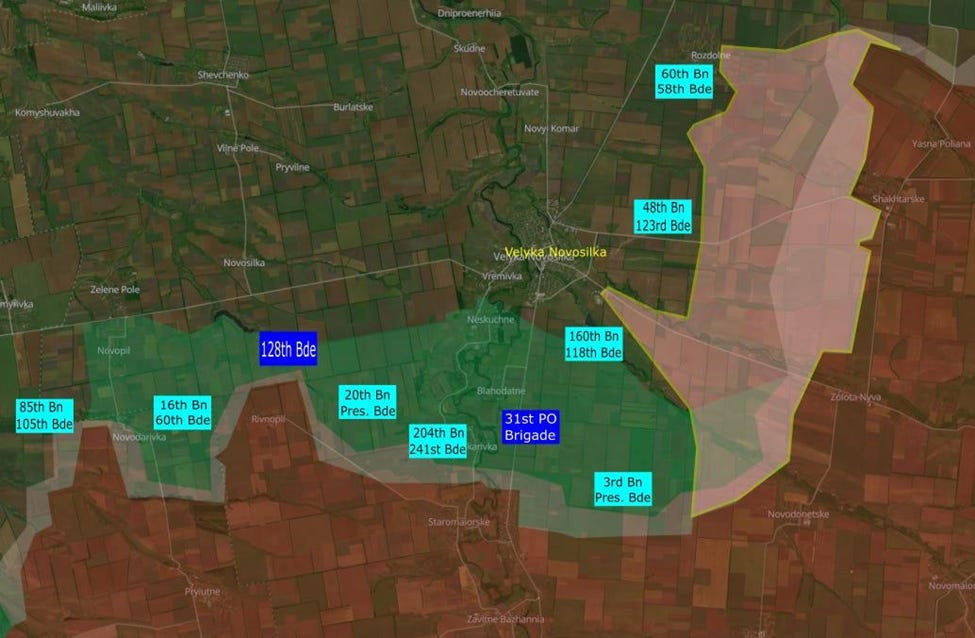(…continued from Part 2…)
***
The Slow Collapse in the Southeast
Six months ago the southeastern front was stable. Then the Russians started making very small gains in the east and Ukraine was unable to make any counterattacks to restore the original defenses. (Some towns and villages are highlighted as reference points). What is more, about four weeks ago the ZSU troops deployed there have - repeatedly - reported the Russians bringing reinforcements to this sector of the frontline. However, this part of Ukraine is so far away from Kyiv, that nobody there in the GenStab-U could hear them…
The result is a slow collapse of the frontlines between Velyka Novosilka and Vuhledar, with plenty of time to observe, orient, decide and - thanks to the fact that the modern-day Russian army is actually a disorganised mob called ‘infantry’ - act. Except for the GenStab-U: when it comes to south-eastern Zaporizhzhya and southern Donetsk, they can’t act reasonably nor quickly at all.
Arguably, the Ukrainian general staff was aware of the looming crisis as early as of June. But, it did virtually nothing. They did not supply the defending units extra ammo or even replacements for their wounded and dead, nor took care to construct a defence line around Velyka Novosilka, or to finish the line stretching from north-west of that town, to Kurakhove. Sure, one might guess that Kyiv was too busy with Pokrovsk - where the Russians were in the process of exploiting their breakthrough at Ocheretyne, from back in April - or with Kursk. However, one also can’t avoid the conclusion that, thanks to their extremely poor field communications and thus their extremely poor unit coordination, the Russians gave the GenStab-U all the time of the world to ‘do something’, and yet, it didn’t.
When there is only one commander making the decisions for all the sectors it is difficult to pay attention to the details ‘everywhere’.
The - initially - very small Russian advances continued and by August they started to gain momentum, increasing in both the rate and width of advance.
Ukraine’s general staff had been feeding in detached battalions to plug holes in the Porkrovsk sector but that didn’t prevent the Russians from advancing 10 km there in August. It merely played into the Russian hands through reducing the number of reinforcements available to the southern sector, though. At this point, the 72nd Brigade was so low on manpower that a kilometer of defensive lines was frequently held by a mere dozen of troops. Simply providing replacements and ammo to the 72nd could have prevented a lot of territorial losses. A brigade with the ability to counterattack could have restored the front. But, nothing happened.
By September, not only was Vuhledar threatened from the east, Russia started advancing to its west, as well. Vuhledar was overrun and Russia expanded its attacks to Rivnopil. Ukraine’s response was to send some brigades and a lot of independent and detached battalions to fill the gaps. They had little time to form defenses and coordinate with their adjacent units. When one unit was pushed back, it forced the withdrawal of the adjacent units. This, in turn, forced the withdrawal of adjacent units.
The collapse would now be very difficult to stop. It would require a different approach by the Ukrainian general staff. But the Ukrainian general staff does not change its approach, even after repeated failures using the same procedures and doctrine.
In the last month, Russia has advanced as much as 12 km, or 3000 meters per week. For comparison: back in July, the fastest sustained rate of advance for any sector was Avdiivka, which averaged 465 meters per week - and that over 43 weeks.
These ‘fast’ Russian advances are now threatening the defenses of Velyka Novosilka from the east.
Once again: this was a slow collapse with plenty of time to observe, orient, decide and to act. However, when the Ukrainian general staff observed the situation back in June they did virtually nothing. They kept observing the situation but did not reorient with a new plan. The decisions they made were based on observations that were since overcome by events. And the ZSU commanders in this area had far too few troops, equipment, and daring (or were too disciplined) to do anything on their own.
The unraveling of the defensive line continues. Mud and snow could slow the Russians down. So could the straightening of the lines. From Rozdolne to Katerynivka to Zoria there are 16 Ukrainian brigades and 14 independent or detached battalions. In an organized defense, about eight brigades could defend a line from Rozdolne to Zoria. But those two villages are the shoulders of the pocket and they need to be held as Ukraine is pushed back or withdrawing from the pocket.
Of course, beginning a reorganization with divisions and corps, and assigning them frontage small enough so they can establish a reserve to react to enemy actions, and giving them the independence to take action would also be useful. But, no need to worry, dear readers: that’s not going to happen, because the GenStab-U knows the best.
***
Velyka Novosilka
When Russia started to advance in this sector there were no local reserves to shore up the line let alone counterattack. Instead, the GenStab-U patched up the frontline in a particularly dilatantic fashion:
● The 60th Battalion was pulled from the 58th Brigade, currently in the Vovchansk sector.
● The 48th Battalion came from the much closer 123rd Brigade, only 20 km away in a straight line, but there are two friendly battalions and two brigades in between it and its parent unit.
● The 160th Battalion’s brigade is in Siversk.
● The 3rd and 20th battalions of the Presidential Brigade are just 10 km from each other but there are a different battalion and then a different brigade in between them. Two more battalions of the brigade are north of Terny (not working with each other, of course).
● The parent unit of the 204th battalion is in Chasiv Yar.
● The 16th Battalion’s home unit is near Terny.
● The 85th Battalion belongs to the 105th Brigade, which is north of Kupiansk.
Any non-commissioned officer with a ‘few years’ of experience from field exercises, and taking his job seriously enough, is certain to know: reserves need to be close enough to provide a timely reaction to enemy operations, whether they are plugged into the defensive line or counterattacking. If they are moving across the country, that adds at least a couple of days for travel when hours could be critical. Once reinforcements arrive, they are often assigned to a brigade that will coordinate its supplies and operations.
But, the Golovkom and his GenStab-U are such giant experts, they can’t care about such issues. They have got only two complete brigades in this sector - a national guard unit and a territorial defence police unit - but there is no clarity even if these two are serving as the base units, or are the battalions rushed to help them expected to coordinate on their own. Indeed, right now, there is no evidence that the Golovkom and his GenStab-U are even trying to conduct the logistical and operational coordination. Whatever the plan was (if there was any…which, in the case of these two instances: is anything else than ‘certain’), it’s not working.
What a surprise that Velyka Novosilka is now threatened of being overrun from the east.
Sure, the 3rd Battalion of the Presidential Brigade (yes, a single battalion), continues to be successful in destroying assaults of an entire Russian division (the 127th Motor-Rifle) from the south. However, east of it, the ill-equipped and -trained battalion of the 123rd Territorial Defence Brigade - itself cobbled together from elements of three different battalions of that unit (because hundreds of troops of the 123rd have repeatedly protested when informed they’re going to be sent to this sector, back in September, and then defected when the GenStab-U didn’t react) - is constantly pushed back. As a result, the 3rd Battalion is now on the best way of ending being encircled.
A small Russian assault group made it into Velyka Novosilka.
***
Zaporizhzhia
A Ukrainian airstrike hits a Russian trenchline.
Explosions were heard in occupied Berdiansk.
***
Crimea
Novofedorivka and Saky airfields had reports of explosions.
***
Unknown Location
A couple views of drones seeking mutual destruction.
A Russian armored vehicle crew records the fact that an adjacent vehicle was targeted by a Javelin ATGM instead of them.
Another batch of fiber optic drone attacks.
This Russian video shows a Russian soldier trying to warn an oncoming Russian vehicle about mines ahead. For his efforts, he is hit by the vehicle.
***
(…to be continued…)









Thanks for the update, although the description of the collapse only fills me with sadness. One general simply cannot micromanaged this war.